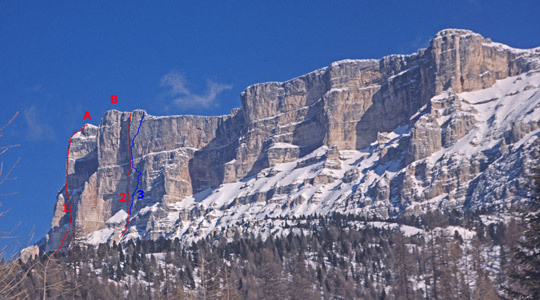
The west face of the Sass dia Crusc (2825m) rises above the Badia Valley. (A) The left-hand or Livanos Pillar. (B) The Central Pillar. (1) Livanos Pillar (VII- [5.10b], 500m, Gabriel-Livanos, 1953). (2) Meyerl Diedre (VII [5.10d], 550m, Mayerl-Rahracher, 1962). (3) La Perla Preziosa (IX+ [5.13a/b], 8 pitches of new climbing, 375m, Sartori-Tondini-Zandegiacomo, 2008). [Photo] Claudio Cima
One of the foremost current Dolomite activists, Nicola Tondini, has completed a free ascent of La Perla Preziosa (Precious Pearl) on the magnificent west face of the Sass dia Crusc (aka Sasso della Croce or Heiligkreuzkofel, 2825m) in the Fanis region of the Italian Dolomites.
With various partners Tondini worked on the route over two days in 2006, another couple in 2007, and then over several days during the period August 12-28 this year. Continuing his philosophy of attempting to create hard traditionally protected routes on the great Dolomite walls, in 2006 Tondini spied a line to the right of the now-classic Meyerl Diedre (UIAA VII [5.10d], 550m, Mayerl-Rahracher, 1962) that he thought might go, and he set to work on the lower section with regular partner Nicola Sartori.
Using just nuts, Friends and pitons, the pair climbed the first four pitches to the midway ledge. In a smooth diedre on the third pitch, Tondini was hanging from a small wire while trying to hammer a solid protection peg, when he widened the crack. The nut popped and he took a 20m fall. This pitch was finally climbed at VIII- (5.11c/d) and the pitch above at VIII (5.12a).
On the midway ledge he had a shock. The line on the imposing upper wall that he had studied from below with binoculars had some pitons. He knew nothing of an ascent in this area, and it was only the following year that he discovered Hansjorg Auer had climbed it in 2005.
In 2006 Tondini returned with his sister and then again with Michael Zandegiacomo, whom Tondini was instructing to become an Alpine guide. Another line was found to the right, but this ended at a point where there were only two possibilities for upward progress: more or less in the same line on very rotten rock, or out right on a superb compact wall of brilliant “Verdonesque” limestone. The problem with the latter was the complete absence of any protection. Tondini went away to think about it for a year.
In 2008 he was back and, reluctantly, decided to place two bolts on the compact wall while hanging from hooks. After some work and a few falls, this crux pitch finally went at IX+ (5.13a/b). Above, the difficulties, though still notable, gradually eased.
Tondini returned for the final redpoint ascent on August 28 with Sartori and Zandegiacomo. Although disappointed that the dream was not perfect, he was happy that for more than 90 percent of the climb the difficult moves on each pitch are obligatory.
The first really significant route to be completed on the broad west face dates from 1953, when Robert Gabriel and Georges Livanos, forming one of the most active partnerships of the era, climbed the superb left-hand pillar, now known as the Livanos Pillar. The next route, which was surprisingly climbed in winter, took the conspicuous diedre right of the three main pillars but left of the huge vertical wall known as the Gran Muro. This was the Meyerl (aka West) Diedre (V+ [5.8] and A2 but now free at VII [5.10d], 550m, Mayerl-Rahracher, 1962).
In 1968 two young brothers decided to tackle the Central Pillar and unwittingly completed one of the most historic ascents in the Alps. The lower part to the half-way ledge proved reasonably straightforward though loose (and today is generally avoided by climbing the first half of the Meyerl Diedre then traversing left). Above, the pair was unable to climb the crest and was forced to traverse right below a large overhang and into the middle of the steep right flank.
In the lead, part way up the third pitch above the ledge, one of the brothers, Reinhold, found himself in a spot of bother…” a smooth slab without any cracks and hardly any holds. Four meters higher a break. I was perched on a small ledge with an overhang and a lot of space below me. I didn’t give up. I tried again, and again, and again. Thirty minutes later I had still not advanced one centimeter. There was no way back. I couldn’t climb down–no chance, and no courage to jump.”
Eventually he made it. However, subsequent attempts to repeat the Messner line by several talented parties all came to a complete standstill at this “4-meter slab.” It wasn’t until 1978 that Hans Mariacher traversed well right from this point and found a way through the wall above to join the original route. Mariacher’s variant is VII but has plenty of in-situ gear. Until the mid 1990s Messner’s original line had only been repeated on a top rope; the rock at this point is a little friable and the crux moves are badly positioned above an ankle-snapping (or worse) ledge. The consensus grade is VIII (5.12a). Not only had Messner broken through to the “Seventh Grade” in 1968 but he appears to have climbed the first grade VIII in Europe’s high mountains.